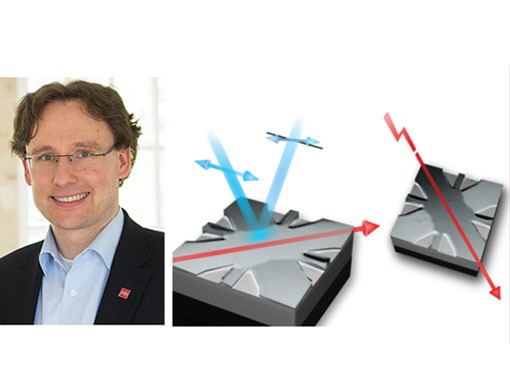Topological Antiferromagnetic Spintronics

Askja
Room 132
Dr. Mathias Kläui, Professor of Physics at Johannes Gutenberg-University Mainz and adjunct professor at the Norwegian University of Science and Technology gives a lecture titled Topological Antiferromagnetic Spintronics.
He received his PhD at the University of Cambridge, after which he joined the IBM Research Labs in Zürich. He was a junior group leader at the University of Konstanz and then became associate professor in a joint appointment between the EPFL and the PSI in Switzerland before moving to Mainz. His research focuses on nanomagnetism and spin dynamics on the nanoscale in new materials. His research covers from blue sky fundamental science to applied projects with major industrial partners. He has published more than 300 articles and given more than 200 invited talks. He is a Senior member of the IEEE and, a Fellow of the IOP and APS and has been awarded a number of prizes and scholarships.
He is one of the 2020/2021 IEEE Magnetics Society Distinguished Lecturers.
Contact details and more information at www.klaeui-lab.de
Abstract
While known for a long time, antiferromagnetically ordered systems have previously been considered, as expressed by Louis Néel in his Nobel Prize Lecture, to be “interesting but useless”. However, since antiferromagnets potentially promises faster operation, enhanced stability with respect to interfering magnetic fields and higher integration due to the absence of dipolar coupling, they could potentially become a game changer for new spintronic devices. The zero net moment makes manipulation using conventional magnetic fields challenging. However recently, these materials have received renewed attention due to possible manipulation based on new approaches such as photons [1] or spin-orbit torques [2].
In this talk, we will present an overview of the key features of antiferromagnets to potentially functionalize their unique properties. This includes writing, reading and transporting information using antiferromagnets and using topologically stabilized spin structured as information carriers.
We recently realized switching in the metallic antiferromagnet Mn2Au by intrinsic staggered spin-orbit torques [3,4] and characterize the switching properties by direct imaging. While switching by staggered intrinsic spin-orbit torques in metallic AFMs requires special structural asymmetry, interfacial non-staggered spin-orbit torques can switch multilayers of many insulating AFMs capped with heavy metal layers.
We probe switching and spin transport in selected collinear insulating antiferromagnets, such as NiO [5-7], CoO [8,9] and hematite [10,11], where we identify multiple switching mechanisms [5,7,9]. For the spin transport, spin currents are generated by heating as resulting from the spin Seebeck effect and by spin pumping measurements and we find in vertical transport short (few nm) spin diffusion lengths [6,8]. For hematite, however, we find in a non-local geometry that spin transport of tens of micrometers is possible [10,11]. We detect a first harmonic signal, related to the spin conductance, that exhibits a maximum at the spin-flop reorientation, while the second harmonic signal, related to the Spin Seebeck conductance, is linear in the amplitude of the applied magnetic field [10]. The first signal is dependent on the direction of the Néel vector and the second one depends on the induced magnetic moment due to the field. We identify the domain structure as the limiting factor for the spin transport [11]. In particular we find in addition to domains and domain walls topologically non-trivial skyrmionic spin structures [12]. Such skyrmions exhibit exciting dynamic properties, such as the skyrmion Hall effect and could be useful for unconventional computing [13].
References
[1] A. Kimel et al., Nature 429, 850 (2004).
[2] J. Zelezny et al., Phys. Rev. Lett. 113, 157201 (2014); P. Wadley et al., Science 351, 587 (2016).
[3] S. Bodnar et al., Nature Commun. 9, 348 (2018)
[4] S. Bodnar et al., Phys. Rev. B 99, 140409(R) (2019); S.P. Bommanaboyena et al., arxiv:2106.02333
[5] L. Baldrati et al., Phys. Rev. Lett. 123, 177201 (2019)
[6] L. Baldrati et al., Phys. Rev. B 98, 024422 (2018); L. Baldrati et al. Phys. Rev. B 98, 014409 (2018)
[7] F. Schreiber et al., Appl. Phys. Lett. 117, 082401 (2020); H. Meer et al., Nano Lett. 21, 114 (2020)
[8] J. Cramer et al., Nature Commun. 9, 1089 (2018)
[9] L. Baldrati et al., Phys. Rev. Lett. 125, 077201 (2020)
[10] R. Lebrun et al., Nature 561, 222 (2018); R. Lebrun et al., Nature Commun. 11, 6332 (2020).
[11] A. Ross et al., Nano Lett. 20, 306 (2020).
[12] A. Ross et al., Phys. Rev. B 102, 094415 (2020).
[13] S. Woo et al., Nat. Mater. 15, 501; K. Litzius et al., Nat Phys. 13, 170, J. Zazvorka et al., Nat. Nano. 14, 658
Dr. Mathias Kläui, Professor of Physics at Johannes Gutenberg-University Mainz gives a lecture titled Topological Antiferromagnetic Spintronics.



